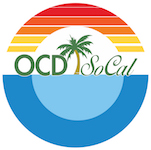Obsessive compulsive disorder (OCD) and OCD-related disorders (OCDRs: hoarding disorder, body dysmorphic disorder, trichotillomania, skin picking disorder) cause enormous suffering for affected individuals. Fortunately, effective treatments exist that include cognitive behavioral therapy (CBT) with or without medication. These treatments are described in more detail below. Regardless of whether you pursue CBT and/or medication, it is essential to find a provider who is experienced and knowledgeable in treating OCD and/or OCDRs using evidence-based strategies. To find a treatment provider located in your area, click here to use the International OCD Foundation (IOCDF) Find Help search.
Treatment of OCD
Exposure and Response Prevention for OCD
By Jennie Kuckertz, MS
Cognitive behavioral therapy (CBT) with exposure and response prevention (ERP) is the gold-standard treatment for OCD in both children and adults. ERP involves purposefully increasing contact with feared situations (triggers) while simultaneously resisting and eventually eliminating compulsions and rituals. Through repeated practice with these graded exposure exercises, individuals with OCD learn: 1. To tolerate uncertainty, 2. Anxiety and discomfort can be tolerated and is not dangerous, 3. Anxiety reduces on its own over time without completing rituals. ERP begins with the creation of a fear hierarchy in which patients list situations that trigger OCD rated along a continuum of low anxiety to maximum anxiety (0-10). Typically in ERP, individuals work their way up the hierarchy gradually as they learn to tackle progressively more difficult exposures. Family members may also be involved in treatment to learn skills for more effectively responding to their loved one’s OCD. In particular, work with family members involves gradual reductions in family accommodation of OCD symptoms, including the extent to which family members provide reassurance, engage in rituals, or facilitate avoidance of feared situations. ERP has been shown effective when delivered in standard outpatient, intensive outpatient, and residential treatment settings. Appropriate treatment setting for any given patient may be determined by a variety of factors, including severity of OCD, accessibility of treatment, cost, etc. In addition, emerging research is examining the efficacy of ERP delivered remotely (e.g. via Skye or other online platforms).
Treatment providers often use the terms ERP and CBT interchangeably. Technically, CBT is a broad set of treatment strategies that may include changing beliefs and behaviors related to OCD, whereas ERP is a specific component of CBT that refers to the completion of exposure exercises and reduction in rituals. However, it is possible that treatment providers advertise offering CBT but do not actually include ERP in the way that they deliver CBT. Regardless of whether a provider refers to their treatment as CBT or ERP, you should ask questions about what treatment involves in order to determine whether treatment includes a focus on exposure to feared situation and reduction in rituals. IOCDF has compiled a useful list of questions to ask when finding an OCD therapist.
Medication for OCD
By Sean Sassano, MD
Medications are an effective treatment for OCD. Patients often choose medication when ERP is not available, they do not have the time for ERP, or when ERP is too anxiety provoking. Medication can also be taken during ERP to help speed recovery. Selective serotonin reuptake inhibitors, such as Zoloft and Prozac, are a good starting point. If these do not work, or aren’t a good choice for you, other medications, such as benzodiazepines (Klonopin), glutamate modulators (N-Acetylcysteine) and dopamine modulators (Abilify) are available. Clomipramine is an older medication that is very strong, and is often helpful even when other medications have not been effective. It is important to note there are some differences in medications for OCD vs. OCD-related disorders. A psychiatrist who specializes in OCD can discuss the many medications available. If the first trial of medication isn’t effective, stay optimistic, as another option may work for you.
Treatment of OCD-Related Disorders
By Barbara Van Noppen, PhD, special thanks to Dr. Eda Gorbis and Piper Haser for their assistance
Treatments for OCD-Related Disorders (OCDRs) also includes variations of Exposure and Response Prevention (ERP), see above, that are tailored to the symptoms of each unique disorder. The unique interventions for Trichotillomania and for Skin Picking (Excoriation Disorder) are similar interventions based upon what was originally called “Habit Reversal Training” (HRT). This is a series of steps where the individual keeps a diary to identify triggers then practices keeping their hands busy by doing other things besides pulling hair or picking sking (behavioral substitution). There is a very good comprehensive approach to treating Trichotillomania called: Comprehensive Model for Behavioral Treatment of Trichotillomania (ComB) that includes numerous dimensions of the various sensory evaluation of Trichotillomania. Refer to Trichotillomania Learning Canter (TLC) site for more information. For Body Dysmorphic Disorder (BDD), a very carefully planned ERP and cognitive restructuring approach is typically the most effective. This involves work with mirrors and learning to re-assess self-appraisals about appearance and perception of appearance. Refer to the IOCDF link to the BDD site for more information. For Hoarding Disorder, the focus is both on discarding as well as resisting acquisitions. This may include “non-shopping” exposures to go to stores, browsing then resisting purchasing items, deleting on-line shopping accounts, cutting up credit cards, etc. Refer to IOCDF website with a link to the Hoarding site for more information.
For more detailed information about treatment of OCD and OCD-related disorders, visit the IOCDF website: https://iocdf.org/about-ocd/treatment/
